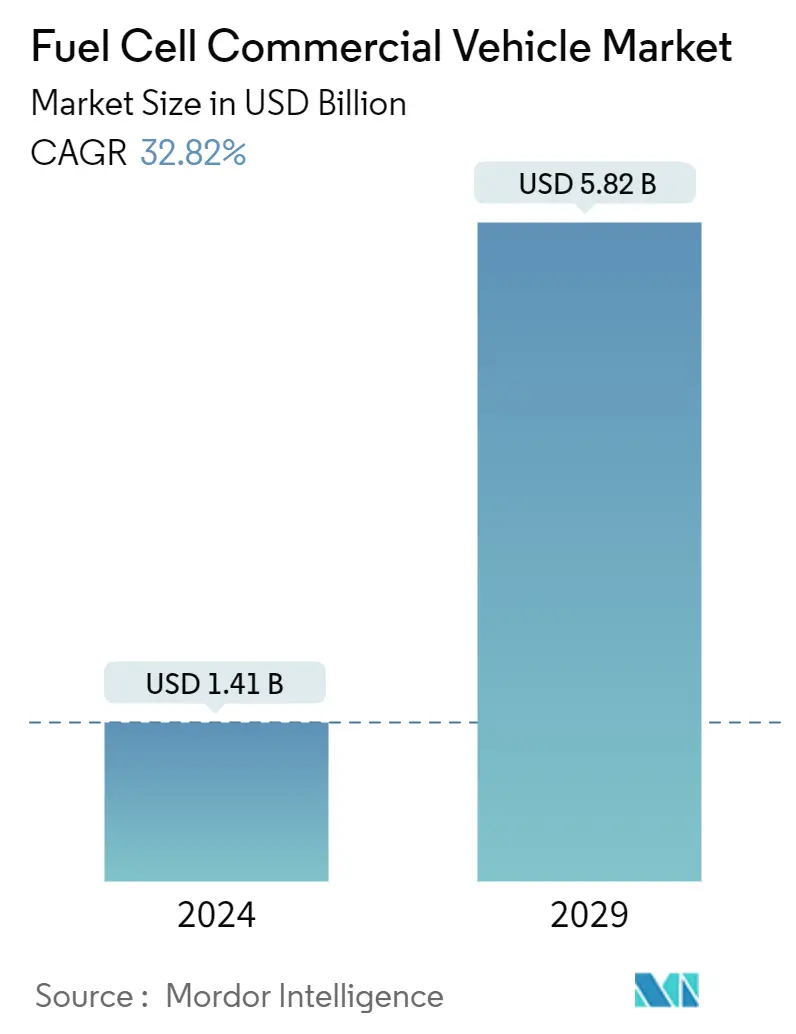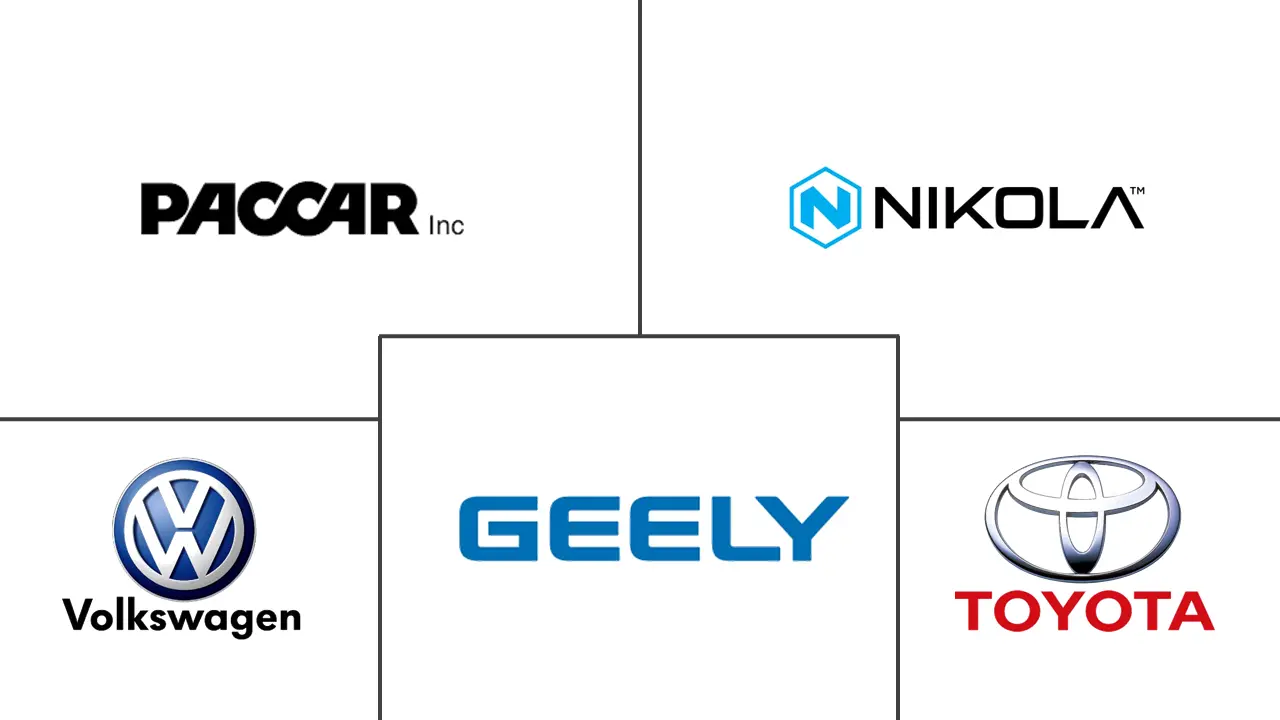Market Size of Fuel Cell Commercial Vehicle Industry

| Study Period | 2019 - 2029 |
| Market Size (2024) | USD 1.41 Billion |
| Market Size (2029) | USD 5.82 Billion |
| CAGR (2024 - 2029) | 32.82 % |
| Fastest Growing Market | Asia-Pacific |
| Largest Market | Asia-Pacific |
Major Players
*Disclaimer: Major Players sorted in no particular order |
Fuel Cell Commercial Vehicle Market Analysis
The Fuel Cell Commercial Vehicle Market size is estimated at USD 1.41 billion in 2024, and is expected to reach USD 5.82 billion by 2029, growing at a CAGR of 32.82% during the forecast period (2024-2029).
Over the long term, the fuel cell commercial market will be driven by the government's enactment of stringent emission norms, growing mass urban transportation, rising demand for alternate fuel vehicles, and increasing investments to enhance hydrogen fuel cell technology. Various governments across the world are increasingly setting emission standards to promote the reduction of carbon emissions. It, in turn, is leading commercial vehicle manufacturers to develop alternative fuel technologies, such as hydrogen fuel cells, which can be incorporated into buses, trucks, and vans, among other vehicles. For instance,
• In August 2022, the Indian government announced a commitment to reduce the Emission Intensity of its GDP by 45% by 2030 compared to 2005 levels. The aggressive policies adopted by the government to tackle carbon emissions are contributing to the surging demand for fuel-cell buses across the country.
• In order to tackle climate change, the European Parliament adopted the European Climate Law, which raises the EU's target of reducing net emissions of greenhouse gas by at least 55% by 2030. From a long-term perspective, the European Union aims to be carbon neutral by the end of 2050.
The fuel cell commercial vehicle market is fairly new compared to the industry's electric and IC engine counterpart markets on a global scale. Due to the early stages of development and production of this technology in vehicles, the market witnessed various incumbents such as Mercedes-Benz, PACCAR, and Toyota, among others, commencing the launch of hydrogen fuel cell commercial vehicles in recent years. However, the market is also witnessing the integration of several entrants, which can change the landscape of the industry through lower-priced offerings than incumbent automakers.
Moreover, buses and trucks have dominated the fuel cell commercial vehicle market, with vans and other light commercial vehicles, such as pickup trucks, only contributing to a smaller share of overall sales worldwide. However, in recent years, various companies have constantly invested hefty sums in their research and development to manufacture fuel cell vans, pickup trucks, and other light commercial vehicles in the market. Such developments are expected to positively impact the demand for fuel-cell commercial vehicles during the forecast period.
• In July 2023, Spectronik, a Singapore-based fuel cell solutions specialist, unveiled the prototype of a van powered by its hydrogen fuel cells system. It can carry up to 1 tonne of cargo. The van includes a range of 500 km and can be refueled rapidly within five minutes, making it a solution that offers environmentally friendly transport and logistics.
With the increasing investments in developing advanced fuel cell technology and the expanding alternative fuel vans and pickup truck demand, the fuel cell commercial market is expected to witness surging growth during the forecast period.
Fuel Cell Commercial Vehicle Industry Segmentation
Fuel cell commercial vehicles refer to trucks, buses, vans, etc., which utilize a fuel cell, sometimes in combination with a small battery or supercapacitor, to power its onboard electric motor. Fuel cells in commercial vehicles generate electricity generally using oxygen from the air and compressed hydrogen.
The fuel cell commercial vehicle market is segmented by vehicle type, power range, and geography. By vehicle type, the market is segmented into buses, trucks, vans, and other vehicle types (pickup trucks, etc.). By power range, the market is segmented into below 100 kW, 100 kW - 200 kW, and above 200 kW. By geography, the market is segmented into North America, Europe, Asia-Pacific, and the Rest of the World.
The report offers market size and forecasts for fuel cell commercial vehicles in value (USD) and volume (units) for all the above segments.
| By Vehicle Type | |
| Buses | |
| Trucks | |
| Vans | |
| Other Vehicle Types (Pickup Trucks, etc.) |
| By Power Range | |
| Below 100 kW | |
| 100 kW - 200 kW | |
| Above 200 kW |
| By Geography | |||||||
| |||||||
| |||||||
| |||||||
|
Fuel Cell Commercial Vehicle Market Size Summary
The fuel cell commercial vehicle market is poised for significant growth, driven by stringent government emission norms, increasing urban transportation needs, and a rising demand for alternative fuel vehicles. The market is relatively nascent compared to electric and internal combustion engine vehicles, but it is gaining momentum as governments worldwide push for reduced carbon emissions. This has led to commercial vehicle manufacturers focusing on developing hydrogen fuel cell technologies for buses, trucks, and vans. The market is characterized by the entry of both established players like Mercedes-Benz and Toyota, and new entrants offering competitive pricing, which is expected to reshape the industry landscape. The integration of fuel cell technology in buses has been particularly prominent, with countries such as China, South Korea, and the United States expanding their fleets of hydrogen-powered buses. This trend is supported by collaborations between government and private sectors to promote eco-friendly transportation solutions.
The Asia-Pacific region is anticipated to lead the market due to advancements in public transportation infrastructure and significant investments in alternative fuel vehicles. Major manufacturers in the region, including Zhejiang Geely Holding Group, Tata Motors, and Toyota Motor Corporation, are actively producing fuel cell buses and trucks to align with government efforts to electrify commercial vehicle fleets. The region's growth is further bolstered by the increasing number of hydrogen fueling stations, with China and Japan at the forefront. The market is highly competitive, with key players like PACCAR Inc., Volkswagen Group, and Hyundai Motor engaging in partnerships to enhance their market presence. Recent developments, such as Tata Motors' delivery of hydrogen fuel cell buses in India and General Motors' collaboration with Autocar Industries for zero-emission trucks, highlight the ongoing advancements in fuel cell technology. These efforts are expected to drive the market's expansion, with a focus on trucks and buses, as companies strive to gain a competitive edge.
Fuel Cell Commercial Vehicle Market Size - Table of Contents
-
1. MARKET DYNAMICS
-
1.1 Market Drivers
-
1.1.1 Aggressive Push by Governments to Promote the Adoption of New-Energy Vehicles to Foster Market Growth
-
-
1.2 Market Restraints
-
1.2.1 High Initial Cost of Purchase to Hamper the Growth of the Market
-
-
1.3 Industry Attractiveness - Porter's Five Forces' Analysis
-
1.3.1 Bargaining Power of Suppliers
-
1.3.2 Bargaining Power of Buyers/Consumers
-
1.3.3 Threat of New Entrants
-
1.3.4 Threat of Substitute Products
-
1.3.5 Intensity of Competitive Rivalry
-
-
-
2. MARKET SEGMENTATION (Market Size in Value - USD and Volume - Units)
-
2.1 By Vehicle Type
-
2.1.1 Buses
-
2.1.2 Trucks
-
2.1.3 Vans
-
2.1.4 Other Vehicle Types (Pickup Trucks, etc.)
-
-
2.2 By Power Range
-
2.2.1 Below 100 kW
-
2.2.2 100 kW - 200 kW
-
2.2.3 Above 200 kW
-
-
2.3 By Geography
-
2.3.1 North America
-
2.3.1.1 United States
-
2.3.1.2 Canada
-
2.3.1.3 Rest of North America
-
-
2.3.2 Europe
-
2.3.2.1 Germany
-
2.3.2.2 United Kingdom
-
2.3.2.3 France
-
2.3.2.4 Italy
-
2.3.2.5 Rest of Europe
-
-
2.3.3 Asia-Pacific
-
2.3.3.1 China
-
2.3.3.2 India
-
2.3.3.3 Japan
-
2.3.3.4 South Korea
-
2.3.3.5 Rest of Asia-Pacific
-
-
2.3.4 Rest of the World
-
2.3.4.1 South America
-
2.3.4.2 Middle East and Africa
-
-
-
Fuel Cell Commercial Vehicle Market Size FAQs
How big is the Fuel Cell Commercial Vehicle Market?
The Fuel Cell Commercial Vehicle Market size is expected to reach USD 1.41 billion in 2024 and grow at a CAGR of 32.82% to reach USD 5.82 billion by 2029.
What is the current Fuel Cell Commercial Vehicle Market size?
In 2024, the Fuel Cell Commercial Vehicle Market size is expected to reach USD 1.41 billion.

